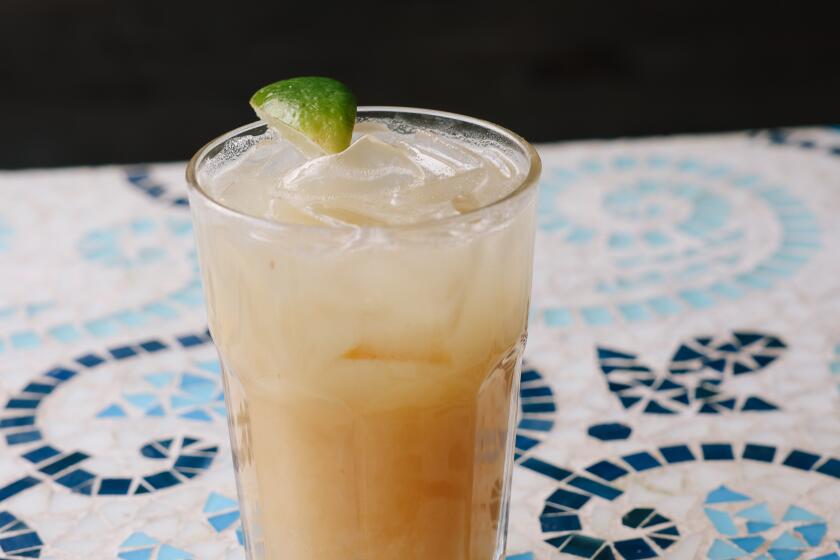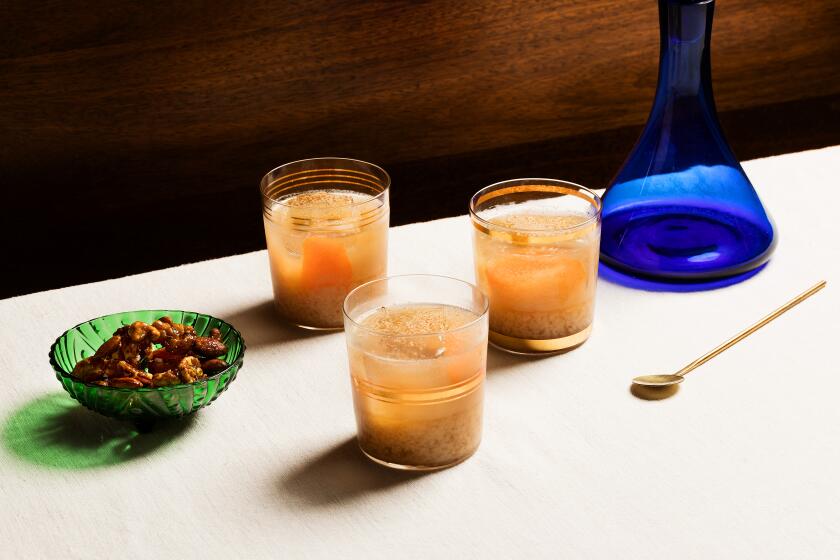Cafe sua da (Iced Vietnamese coffee)
A baguette, still warm from the oven, its golden crust trellised with cracks. Sandwiched inside, a bright green thatch of cilantro and jalapenos, a tangle of pickled carrots and daikon, a smear of pate. Loaded between that, maybe a layer of rich barbecued pork or zesty meatballs, even spicy sardines. This is banh mi, an addictive Vietnamese street food and the culinary pay dirt of French colonialism.
Across Westminster’s Little Saigon, old men gossip and read the morning copy of Viet Bao at metal cafe tables, sipping glasses of strong coffee laced with sweetened, condensed milk and crunching into the day’s first banh mi.
There are shops selling the community’s unique fast food everywhere, tucked between coin-op laundromats and fruit stands loaded with jackfruit and durian, hidden like gifts in a concrete horizontal landscape of strip malls.
Local cooking instructors Diane Cu and her partner of a dozen years, Todd Porter, who live in nearby Costa Mesa, spend nearly as much time in these little shops as the old men. (They have an entire section devoted to banh mi on their website, www.whiteonricecouple.com.)
The Vietnamese coffee shops and French bakeries form a patchwork quilt of both cultures, offering boba and croissants, spring rolls and beignets, plantains and pennywort tea. It’s easy to see why they’re so inviting, why loyal patrons scout out their preferred cafes -- and stay away from others.
“I think my dad knows where we go,” says Cu, explaining that her father avoids her favorite shops so that Cu won’t tell her mother where he is and cut into his coffee shop time.
Cu, whose family moved from Da Nang, Vietnam, to Southern California when she was a child, and Porter, a native of Oregon, explain that a great banh mi starts with a great baguette. The best are lighter than many European-style baguettes, baked with a percentage of rice flour along with the wheat flour.
Fresher than fresh
In Westminster, the biggest Vietnamese community outside of Vietnam, most banh mi shops are also bakeries. Often tiny storefronts deepen into long rows of ovens, where freshly baked baguettes commonly are pulled out every few minutes.
“An hour and a half is considered old,” Cu says. “Anything that’s not hot is half-price.” Even so, often baguettes are priced 2 for 1 -- as are the banh mi in many shops.
The price of banh mi is also one of its key components: Most sandwiches go for under $3. Even that’s considered a lot in Westminster, but prices have risen lately with the rise in food prices (especially flour), Cu says. “$2.50 a sandwich is outrageous,” she says, remembering days when the sandwiches cost less than $2.
After the baguette, the fillings are the most important aspect of the sandwich, a savory combination of Vietnamese, French and California components. Spicy Chinese-style pork barbecue laced with lemon grass and pickled daikon; baguette and pate; cilantro and jalapeno. It’s the perfect post-colonial hybrid.
If you can’t make it to your nearest banh mi shop, it’s easy to make your own. Sure, it won’t have the same atmospheric setting (your baguette just pulled warm from a metal cart, the caffeine-fueled camaraderie), but it beats getting stuck in traffic or having to wait in long lines.
Making banh mi is more a matter of assembly than cooking, especially when you go with an easy filling of sardines (a classic banh mi ingredient) instead of a more labor-intensive barbecue. A single baguette yields four generous sandwiches -- or one long one, if you want to have a banh mi party.
Spread the bread with a thin layer of mayonnaise, another of prepared pork liver pate (both ingredients signal the French influence), then break up whole sardines -- those packed in tomato sauce are favored -- with a pair of chopsticks. Cu points out that although most Vietnamese will keep the little bones intact, it’s easy to remove them if you like.
Then load the sandwich with pickled carrots and daikon, slices of cucumber and jalapeno, and a generous amount of cilantro and mint. Cu and Porter, who just got back from a trip to Vietnam to visit Cu’s relatives, say that although mint isn’t customary in Southern California banh mi, it’s common in Vietnam, as is Vietnamese coriander (rau ram).
Slivered carrots and daikon, quick-pickled in brine for less than an hour, are a standard component in banh mi, although Cu saw them replaced with fresh green papaya while in Vietnam. (“We saw cilantro once in Da Nang,” says Cu, of the fresh herb so prevalent in Southern California banh mi.)
A few more sprigs of cilantro, stems and all, then a dash of soy sauce and you’re done.
As Cu talks, Porter has been busy brewing Vietnamese coffee on the other side of the kitchen, using one of the metal coffee filters the couple has stacked by their Breville espresso maker.
A few tablespoons of coffee (Cafe du Monde, a New Orleans brand made with chicory, is popular in the Vietnamese community; Porter also likes to use Ethiopian beans or an espresso blend) go into the little filters, which go for about $4 at an Asian grocery store. The coffee is then brewed straight into a glass filled with a pour of sweetened condensed milk, where the coffee drips to form a gorgeous layer of black over the pale ivory of the milk.
For hot coffee (cafe sua nong), Porter nests the glass into a tumbler filled with hot water to maintain the temperature, then stirs the milk and coffee. For iced coffee (cafe sua da), he mixes the drink, then pours it over ice.
A glass of milky coffee, a sardine banh mi, the crusty baguette loaded with cilantro, chiles and fresh mint from their garden. Can you make it differently? Of course, says Cu. Banh mi is post-colonial comfort food: The sandwiches are by their very nature adaptive, changing with the territory, reflecting seasonal ingredients and taking on the personality of whoever makes them.
“I would never diss what your mom makes,” Cu says. “My mom doesn’t make it the way I do either.”
Bring a small pot of water to boil over high heat.
Pour the sweetened condensed milk into an 8- to 10-ounce glass.
Unscrew the top of the coffee filter. Place the coffee in the filter, then replace the top, screwing it tightly to compact the grounds. Fit the filter over the glass and pour in just enough hot water to wet the coffee. Allow it to hydrate for 30 seconds.
Loosen the filter screen screw at least 2 full rotations so the water can pass through the coffee. Pour hot water to the top of the filter, replace the filter lid and wait for the coffee to pass through; this should take about 5 minutes.
Remove the filter and stir the coffee and condensed milk. Fill the glass with ice and serve immediately.
Get our Cooking newsletter.
Your roundup of inspiring recipes and kitchen tricks.
You may occasionally receive promotional content from the Los Angeles Times.
















